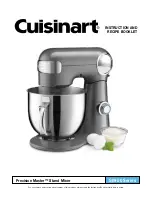
8
(105°F–110°F) water and add a pinch of
sugar or flour from the recipe. If it does not
become foamy/bubbly in 5 to 10 minutes,
the yeast may be “dead.” Start over with
fresh yeast from a new package.
COOKIE BAKING
• Use an ice cream scoop to measure out
cookie dough – this keeps the cookies
evenly shaped and uniform in size. We rec-
ommend ice cream scoops in several sizes
– #40, #50 and #60, as well as a larger one
(about
1
⁄
3
to ½ cup) for jumbo cookies. Ice
cream scoops are also good for filling muffin
tins. Use a #16 ice cream scoop to make
muffins or meatballs.
• To better maintain cookie shapes, put
scoops of cookie dough onto sheets of
waxed paper or plastic wrap on a tray and
chill before baking. Most cookie dough can
be refrigerated for 2 to 3 days prior to baking
– be sure to wrap well.
• Cookie dough may also be frozen. Shape
into individual cookies, double wrap and
freeze for up to 3 months. Thaw before
baking.
• Line baking sheets with parchment paper for
easy release and easy cleanup.
• Let cookies rest on sheets for 2 to 3 minutes
before removing them to a wire rack to cool.
This keeps cookies from wrinkling, crum-
bling or breaking.
• Cookies must cool completely before being
put into storage containers to ensure they
don’t get soggy or misshapen.
BREAD BAKING
• One ¼-ounce packet of yeast equals 2¼
teaspoons yeast.
• Using milk in place of water will produce a
softer crust.
• After baking, you can soften the crust, if
desired, by rubbing it with unsalted butter
soon after removing it from the oven. This
prevents it from drying out quickly.
• If a recipe calls for a specific type of flour,
use the flour recommended. If you do not
have bread flour, you can substitute un-
bleached, all-purpose flour, but your bread
may not rise quite as much.
• Do not use “lite” or tub margarines for bread
baking – they have different structures and
they do not work as well in baking.
• Vital wheat gluten is the dried protein taken
from the flour by eliminating the starch. It is
a good dough conditioner or enhancement
for yeast breads, especially for whole-grain
breads or when using all-purpose flour. If a
recipe specifically calls for vital wheat
gluten, we recommend that it be used for
best results.
• For 100% whole-wheat bread, use 1½
teaspoons vital wheat gluten per cup of flour.
• Lite salt can be used if it has both potassium
chloride and sodium.
• Many bread recipes have a “range” amount
of flour – start by using the lower end of the
range, then add more flour as needed to
produce a smooth, not sticky dough.
• Using too much liquid, or baking on a humid
day, can cause your bread to fall or wrinkle
on top.
• An instant-read thermometer is helpful to
have on hand when making bread. It can
be used to measure the temperature of the
liquid for proofing yeast, and for taking the
internal temperature of the baked bread.
• Liquid for proofing yeast should be between
105°F and 110°F.
• Finished bread should have an internal tem-
perature of 190°F (enriched breads, those
that normally include eggs, are done at a
higher temperature, closer to 207°F).
CAKE BAKING
• Have all ingredients and mixing bowls at
room temperature. Room temperature ingre-
dients incorporate and blend more easily.
• Fill pans immediately after mixing.
• Bake immediately after filling pans.
• Check for doneness at the beginning of the
time range given.
• Cool cakes in pans until cool to touch, and
remove from pans to completely cool on a
wire rack after baking.
• An offset spatula will make spreading








































